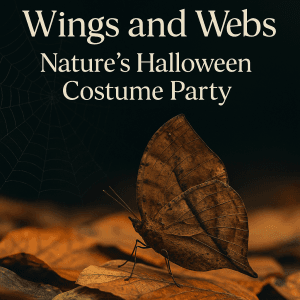
When it comes to escaping winter, butterflies have options. Monarchs grab the spotlight, fluttering thousands of miles to Mexico like tiny orange tourists chasing the sun. But what about everyone else?
The truth is, most butterflies don’t migrate at all. Instead, they tough it out — tucked in, frozen still, or quietly biding their time. Let’s explore who hibernates, who hides, and who (literally) wings it south.
🥶 Strategy #1: Hibernate Like a Champ
While monarchs hit the road, many butterfly species simply go into dormancy — a sort of suspended animation called diapause.
Some, like the Viceroy or Cabbage White, overwinter as chrysalides, cocooned in the quiet corners of your garden. Others, like the Baltimore Checkerspot, brave the cold as tiny caterpillars tucked under leaves, waiting out the frost like fuzzy little survivalists.
Garden wisdom: Those messy leaf piles you’ve been meaning to rake? They might be hiding next spring’s butterflies. Think of your garden as a five-star hibernation lodge — complimentary leaf blanket included.
🐣 Strategy #2: Eggs on Ice
Some butterflies skip the winter entirely by leaving eggs that outlast the cold. These tough little time capsules rest on stems and branches, ready to hatch when spring finally checks in.
Hairstreaks and Fritillaries are big fans of this method — proof that sometimes, the smartest move in nature is outsourcing the problem to your future kids.
🪶 Strategy #3: Hide, Hibernate, and Hope
Then there are the real risk-takers — butterflies who stay adults through winter.
Species like the Mourning Cloak and Comma butterflies tuck themselves into bark crevices, log piles, or garden sheds. Their secret? Built-in antifreeze chemicals that keep their wings from icing over.
They’re basically the extreme campers of the insect world — no migration, no problem. Just grit, glycerol, and a good hiding spot.
Art inspiration: This quiet endurance makes for beautiful storytelling. Picture a framed print of a butterfly camouflaged in bark — wings folded, still, resilient. Proof that even stillness can be powerful.
🌿 Why It Matters (and How You Can Help)
Understanding these winter strategies helps gardeners and nature lovers support butterflies year-round.
Try this:
- Leave the leaves: Leaf litter shelters overwintering larvae and pupae.
- Delay cleanup: Wait until spring temps stay above 50°F before raking or trimming.
- Plant for next year: Native nectar and host plants create the perfect comeback habitat.
For art lovers, it’s a reminder that transformation doesn’t always mean motion. Sometimes, the beauty is in the pause. Explore butterfly-inspired decor that celebrates this cycle at The Butterfly Connection.
✨ The Takeaway
So yes, monarchs are the jet-setters — they’ve earned their frequent flyer wings. But for thousands of other species, winter is a waiting game. Whether they hibernate, hide, or tough it out under a blanket of leaves, butterflies remind us that resilience comes in many forms.
Because even in the quietest seasons, nature is still at work — resting, readying, and reinventing itself for the next big bloom.
🌼 Related Reads
Share:
Social Media
Most Popular
Subscribe To Our Newsletter
Categories
- Education (27)
- Family (5)
- Fun Facts (19)
- Inspiration (26)
- Local (2)
- News (1)
- Science (7)
- Technology (2)
Related Posts

Hibernate, Hide, or Head South: The Great Butterfly Winter Debate
When it comes to escaping winter, butterflies have options. Monarchs grab the spotlight, fluttering thousands of miles to Mexico like tiny orange tourists chasing the

Wings and Webs: Nature’s Halloween Costume Party
While you’re picking out a Halloween costume, nature’s already ahead of you. From wings that look like dead leaves to patterns that scream “Don’t eat

Butterflies of the Afterlife: How Cultures Around the World See Souls in Flight
Wings Between Worlds: A Timeless Belief Since ancient times, butterflies have been seen as more than mere insects — they’ve been viewed as messengers between

Real Resin-Encased Scorpions Are This Season’s Darkest Décor Trend
When Nature Gets a Little Dangerous Forget plastic pumpkins and foam spiders—this Halloween, the décor trend with real sting is authentic resin-encased scorpions. Each one,

When it comes to escaping winter, butterflies have options. Monarchs grab the spotlight, fluttering thousands of miles to Mexico like tiny orange tourists chasing the sun. But what about everyone else?
The truth is, most butterflies don’t migrate at all. Instead, they tough it out — tucked in, frozen still, or quietly biding their time. Let’s explore who hibernates, who hides, and who (literally) wings it south.
🥶 Strategy #1: Hibernate Like a Champ
While monarchs hit the road, many butterfly species simply go into dormancy — a sort of suspended animation called diapause.
Some, like the Viceroy or Cabbage White, overwinter as chrysalides, cocooned in the quiet corners of your garden. Others, like the Baltimore Checkerspot, brave the cold as tiny caterpillars tucked under leaves, waiting out the frost like fuzzy little survivalists.
Garden wisdom: Those messy leaf piles you’ve been meaning to rake? They might be hiding next spring’s butterflies. Think of your garden as a five-star hibernation lodge — complimentary leaf blanket included.
🐣 Strategy #2: Eggs on Ice
Some butterflies skip the winter entirely by leaving eggs that outlast the cold. These tough little time capsules rest on stems and branches, ready to hatch when spring finally checks in.
Hairstreaks and Fritillaries are big fans of this method — proof that sometimes, the smartest move in nature is outsourcing the problem to your future kids.
🪶 Strategy #3: Hide, Hibernate, and Hope
Then there are the real risk-takers — butterflies who stay adults through winter.
Species like the Mourning Cloak and Comma butterflies tuck themselves into bark crevices, log piles, or garden sheds. Their secret? Built-in antifreeze chemicals that keep their wings from icing over.
They’re basically the extreme campers of the insect world — no migration, no problem. Just grit, glycerol, and a good hiding spot.
Art inspiration: This quiet endurance makes for beautiful storytelling. Picture a framed print of a butterfly camouflaged in bark — wings folded, still, resilient. Proof that even stillness can be powerful.
🌿 Why It Matters (and How You Can Help)
Understanding these winter strategies helps gardeners and nature lovers support butterflies year-round.
Try this:
- Leave the leaves: Leaf litter shelters overwintering larvae and pupae.
- Delay cleanup: Wait until spring temps stay above 50°F before raking or trimming.
- Plant for next year: Native nectar and host plants create the perfect comeback habitat.
For art lovers, it’s a reminder that transformation doesn’t always mean motion. Sometimes, the beauty is in the pause. Explore butterfly-inspired decor that celebrates this cycle at The Butterfly Connection.
✨ The Takeaway
So yes, monarchs are the jet-setters — they’ve earned their frequent flyer wings. But for thousands of other species, winter is a waiting game. Whether they hibernate, hide, or tough it out under a blanket of leaves, butterflies remind us that resilience comes in many forms.
Because even in the quietest seasons, nature is still at work — resting, readying, and reinventing itself for the next big bloom.
🌼 Related Reads
When it comes to escaping winter, butterflies have options. Monarchs grab the spotlight, fluttering thousands of miles to Mexico like tiny orange tourists chasing the sun. But what about everyone else?
The truth is, most butterflies don’t migrate at all. Instead, they tough it out — tucked in, frozen still, or quietly biding their time. Let’s explore who hibernates, who hides, and who (literally) wings it south.
🥶 Strategy #1: Hibernate Like a Champ
While monarchs hit the road, many butterfly species simply go into dormancy — a sort of suspended animation called diapause.
Some, like the Viceroy or Cabbage White, overwinter as chrysalides, cocooned in the quiet corners of your garden. Others, like the Baltimore Checkerspot, brave the cold as tiny caterpillars tucked under leaves, waiting out the frost like fuzzy little survivalists.
Garden wisdom: Those messy leaf piles you’ve been meaning to rake? They might be hiding next spring’s butterflies. Think of your garden as a five-star hibernation lodge — complimentary leaf blanket included.
🐣 Strategy #2: Eggs on Ice
Some butterflies skip the winter entirely by leaving eggs that outlast the cold. These tough little time capsules rest on stems and branches, ready to hatch when spring finally checks in.
Hairstreaks and Fritillaries are big fans of this method — proof that sometimes, the smartest move in nature is outsourcing the problem to your future kids.
🪶 Strategy #3: Hide, Hibernate, and Hope
Then there are the real risk-takers — butterflies who stay adults through winter.
Species like the Mourning Cloak and Comma butterflies tuck themselves into bark crevices, log piles, or garden sheds. Their secret? Built-in antifreeze chemicals that keep their wings from icing over.
They’re basically the extreme campers of the insect world — no migration, no problem. Just grit, glycerol, and a good hiding spot.
Art inspiration: This quiet endurance makes for beautiful storytelling. Picture a framed print of a butterfly camouflaged in bark — wings folded, still, resilient. Proof that even stillness can be powerful.
🌿 Why It Matters (and How You Can Help)
Understanding these winter strategies helps gardeners and nature lovers support butterflies year-round.
Try this:
- Leave the leaves: Leaf litter shelters overwintering larvae and pupae.
- Delay cleanup: Wait until spring temps stay above 50°F before raking or trimming.
- Plant for next year: Native nectar and host plants create the perfect comeback habitat.
For art lovers, it’s a reminder that transformation doesn’t always mean motion. Sometimes, the beauty is in the pause. Explore butterfly-inspired decor that celebrates this cycle at The Butterfly Connection.
✨ The Takeaway
So yes, monarchs are the jet-setters — they’ve earned their frequent flyer wings. But for thousands of other species, winter is a waiting game. Whether they hibernate, hide, or tough it out under a blanket of leaves, butterflies remind us that resilience comes in many forms.
Because even in the quietest seasons, nature is still at work — resting, readying, and reinventing itself for the next big bloom.





